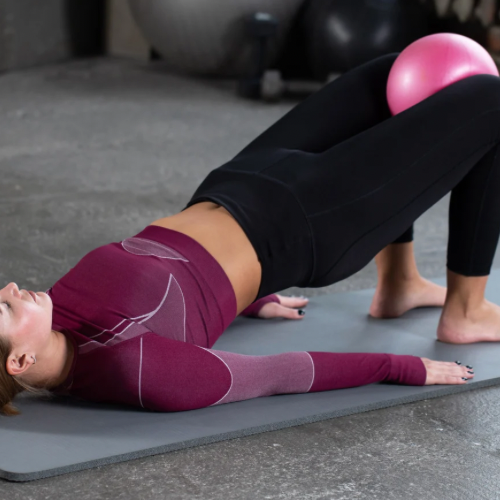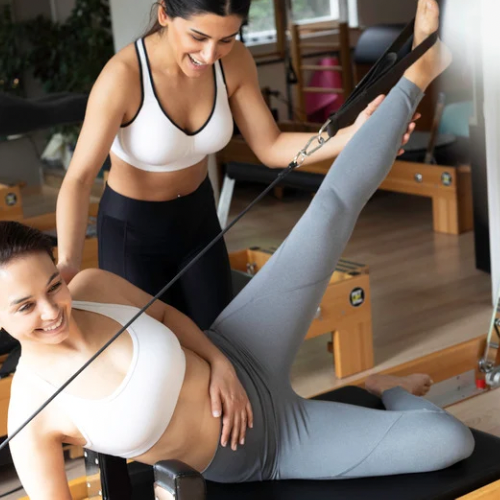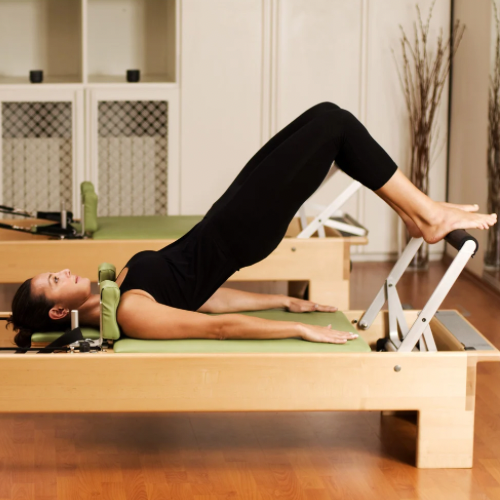
Strong Hips, Happy Back: Why Your Piriformis Matters
- Kris
- Aug 7
- 3 min read
If you’ve ever experienced a deep ache in your glutes or a sharp radiating pain down the back of your leg, you may be familiar with the small but mighty piriformis muscle. Although often overlooked, this muscle plays a vital role in hip mobility, pelvic stability, and overall movement efficiency. In today’s blog, we’re diving into what the piriformis does, how it can get injured, and how Pilates can help keep it strong, flexible, and pain-free.
🔍 What Is the Piriformis?
The piriformis is a flat, band-like muscle located deep in the buttocks, behind the gluteus maximus. It runs from the sacrum (the triangular bone at the base of the spine) to the greater trochanter of the femur (the bony prominence at the top of your thigh).
Function

The piriformis is a flat, band-like muscle located deep in the buttocks, behind the gluteus maximus:
External rotation of the hip: It helps turn the leg outward (think of crossing one ankle over the opposite knee).
Hip abduction (when the hip is flexed): Like moving your leg out to the side when sitting.
Pelvic stabilization: It helps stabilize the pelvis during walking, running, and weight-bearing movements.
⚠️ Common Piriformis Issues
Because of its location and function, the piriformis is prone to dysfunction and tightness, especially in individuals who sit for prolonged periods, athletes, or those with muscle imbalances.
1.Piriformis Syndrome
This condition occurs when the piriformis becomes tight or spasms and compresses the sciatic nerve, which runs directly underneath or through the muscle in some people. Symptoms may include:
Deep glute pain
Numbness or tingling down the leg
Pain that worsens with sitting, climbing stairs, or running
2.Muscle Strain or Overuse
Overuse of the piriformis in activities that involve repetitive hip rotation (like tennis or cycling) can lead to inflammation or strain.

3.Postural Imbalances
Pelvic misalignment, leg length discrepancies, or tight hip flexors can place excess stress on the piriformis.
🧘♀️ How Pilates Can Help
Pilates is one of the most effective approaches to correct muscle imbalances, strengthen the deep core, and improve alignment—all of which support a healthy piriformis.
Benefits of Pilates for Piriformis Health:
Builds glute and hip strength to reduce overuse of the piriformis
Improves spinal and pelvic alignment
Increases mobility and flexibility of the hips and surrounding muscles
Enhances body awareness to correct compensatory movement patterns
💪 Pilates-Based Exercises to Strengthen and Release the Piriformis
Here are a few safe and effective exercises to mobilize, stretch, and strengthen the piriformis and supporting muscles:
1.Clamshells (Side-Lying Hip External Rotation)
How to:
Lie on your side with knees bent and stacked. Keep feet together as you lift the top knee open like a clamshell, keeping your pelvis stable.
Targets: Piriformis, glute medius
Reps: 10–15 each side
2.Figure-4 Stretch (Piriformis Stretch)
How to:
Lie on your back with knees bent. Cross one ankle over the opposite knee. Gently pull the lower leg toward your chest to stretch the piriformis.
Hold: 20–30 seconds per side
3.Bridge with Ball Squeeze
How to:
Lie on your back with feet flat. Place a small Pilates ball or yoga block between your knees. Squeeze the ball and lift into a bridge, focusing on engaging the glutes and hamstrings.
Targets: Glutes, deep hip stabilizers
Reps: 10–15

4.Leg Circles (Pilates Mat Exercise)
How to:
Lie on your back with one leg extended toward the ceiling. Make slow, controlled circles while keeping your hips stable. Focus on isolating movement at the hip joint.
Targets: Hip stabilizers, core
Reps: 5–8 each direction, per leg
5.Side-Lying Leg Lifts
How to:
Lying on your side, lift the top leg slightly behind the body to engage glutes and piriformis. Keep hips stacked and core engaged.
Reps: 10–12 per side
6.Standing

Figure 4 (Pilates Balance Challenge)
How to:
Standing tall, cross one ankle over the opposite thigh. Sit back into a single-leg squat. Keep the standing leg aligned and core engaged.
Challenge: Improves balance, piriformis flexibility, and strength
🙌 Final Thoughts
The piriformis may be small, but it plays a crucial role in keeping your hips, pelvis, and lower back happy. If you’re experiencing discomfort, the solution may lie in rebalancing your muscles and improving your movement patterns, not just stretching endlessly.
Incorporating Pilates into your routine can help you develop the strength, flexibility, and awareness needed to protect the piriformis and keep your body moving with ease.

By clicking the link below, you can access a treasure trove of episodes that cover various aspects of health and wellness. From expert interviews to practical tips and advice, the Kore Kast offers a comprehensive resource to help you on your journey to a healthier lifestyle.





Comments